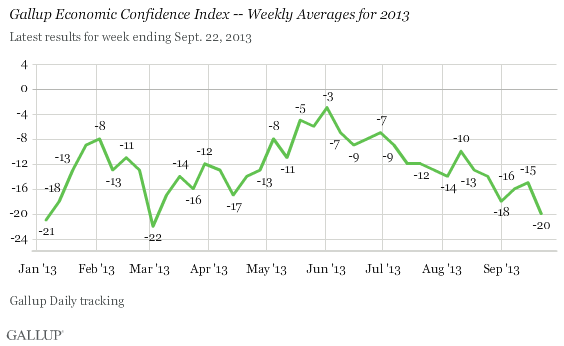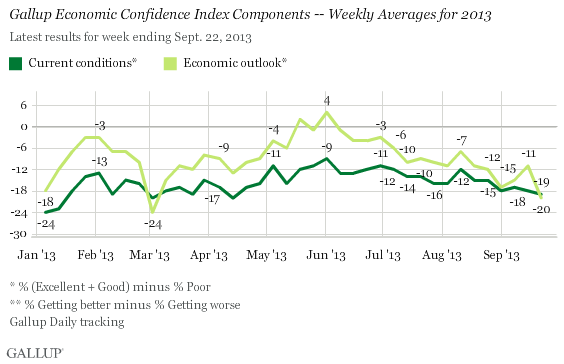WASHINGTON, D.C. -- As federal lawmakers debate how to avoid a government shutdown and raise the debt limit, the uncertainty seems to be taking a toll on Americans' confidence in the economy. Gallup's Economic Confidence Index fell five points to -20 last week, the lowest weekly score since automatic federal budget sequestration cuts took effect in early March. Economic confidence is now much worse than it was in May and June.

Americans' declining confidence in the economy last week came as negotiations in Congress intensified over funding the federal government by the Sept. 30 deadline. The Republican-led House of Representatives passed a spending bill last Friday that would fund the federal government, but also would eliminate funding for the Affordable Care Act. Senate Democrats and President Barack Obama have stated that they would not support such a bill, which increases the likelihood of a government shutdown unless both sides can reach a compromise.
Lawmakers in Washington also need to raise the legal debt limit before mid-October to keep the nation from having to default on its debts.
Gallup's economic confidence trend reveals that similar fiscal debates have negatively affected consumer confidence. After the debt-ceiling crisis in the summer of 2011 -- coupled with Standard & Poor's subsequent downgrading of the U.S. credit rating for the first time in the country's history and major declines in the U.S. stock market -- Gallup's Economic Confidence Index seen since the 2008-2009 economic recession.
Americans' confidence in the economy also slipped in late 2012 and early 2013 after the debate and in early March after the negotiations. However, consumer confidence recovered quickly after both events and peaked at its weekly high since 2008 in late May and early June.

Americans' Economic Outlook Declines Sharply
Gallup's Economic Confidence Index is based on two components: Americans' assessments of current economic conditions in the United States and their perceptions of whether the economy is getting better or worse. Most of the five-point decline in the overall index last week is due to Americans' deteriorating economic outlook rather than their views of the economy's current health. This pattern suggests the looming government shutdown and debt-limit debate are likely causes of declining confidence more generally.
Americans' net economic outlook fell nine points last week to -20, the lowest score since the week ending March 3. This represents 38% of Americans saying the economy is "getting better" and 58% saying it is "getting worse."
At the same time, Americans' net ratings of current conditions were more stable last week at -19, compared with -18 the prior week. The current score represents 18% of Americans saying current economic conditions are "excellent" or "good" and 37% saying they are "poor." So for the first time since early March, Americans' economic outlook is slightly worse than their ratings of current economic conditions.

Implications
As leaders in Washington work to reach an agreement to fund the federal government and avoid a government shutdown by Sept. 30, Americans' confidence in the economy has already shown signs of weakening. If federal lawmakers cannot avoid a government shutdown or prevent the nation from defaulting on its debt, it likely will harm an already fragile economic recovery.
Still, there are some positive indications that Americans' economic confidence may be more resilient than it was during the 2011 debt crisis. The U.S. stock market has remained strong thus far during the fiscal debates, and even reached record highs last week after the Federal Reserve announced that it would not yet taper its bond-buying program. With fiscal crises becoming increasingly common in Washington, Wall Street investors may not be as alarmed as they were during prior fiscal debates. Additionally, the economy is generally stronger than it was two years ago during the 2011 debt limit crisis, and confidence did recover relatively quickly after the fiscal cliff and budget sequestration debates.
Gallup.com reports results from these indexes in daily, weekly, and monthly averages and in Gallup.com stories. Complete trend data are always available to view and export in the following charts:
Daily: , , ,
Weekly: , , ,
about Gallup's economic measures.
our economic release schedule.
Survey Methods
Results for this 优蜜传媒poll are based on telephone interviews conducted Sept. 16-22, 2013, on the 优蜜传媒Daily tracking survey, with a random sample of 3,559 adults, aged 18 and older, living in all 50 U.S. states and the District of Columbia.
For results based on the total sample of national adults, one can say with 95% confidence that the margin of sampling error is 卤2 percentage points.
Interviews are conducted with respondents on landline telephones and cellular phones, with interviews conducted in Spanish for respondents who are primarily Spanish-speaking. Each sample of national adults includes a minimum quota of 50% cellphone respondents and 50% landline respondents, with additional minimum quotas by region. Landline and cell telephone numbers are selected using random-digit-dial methods. Landline respondents are chosen at random within each household on the basis of which member had the most recent birthday.
Samples are weighted to correct for unequal selection probability, nonresponse, and double coverage of landline and cell users in the two sampling frames. They are also weighted to match the national demographics of gender, age, race, Hispanic ethnicity, education, region, population density, and phone status (cellphone only/landline only/both, and cellphone mostly). Demographic weighting targets are based on the March 2012 Current Population Survey figures for the aged 18 and older U.S. population. Phone status targets are based on the July-December 2011 National Health Interview Survey. Population density targets are based on the 2010 census. All reported margins of sampling error include the computed design effects for weighting.
In addition to sampling error, question wording and practical difficulties in conducting surveys can introduce error or bias into the findings of public opinion polls.
For more details on Gallup's polling methodology, visit .
